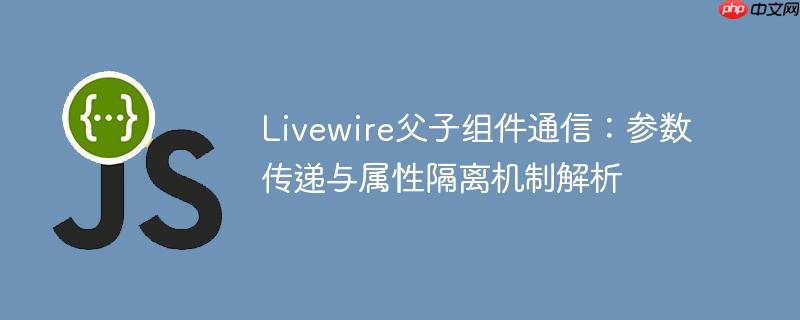
在livewire应用开发中,一个常见的误解是认为父组件的公共属性可以像blade模板的变量一样,自动被其内部包含的子livewire组件访问。然而,livewire组件在设计上是高度独立的,每个livewire组件都拥有自己的生命周期和状态。这意味着父组件中通过wire:model绑定的属性,即使其值在父组件内部已更新(例如在表单提交后),也不会自动同步或暴露给其直接引用的子livewire组件。
原始问题中,父组件的输入框使用了wire:model.defer="title",这确保了title属性在表单提交时才更新到父组件的后端。但是,当尝试在父组件的方法中访问一个预期从子组件获取的属性(如$this->include_service_title),或者期望子组件能自动获取父组件的title属性时,就会遇到属性值为空(null)的情况。这是因为子组件的属性需要显式地从父组件传递,而不是隐式共享。
Livewire组件之间传递数据的正确方式是通过显式参数。这与传统PHP类或函数调用时传递参数的机制类似。当你在父组件的Blade视图中渲染子Livewire组件时,你可以像传递属性给普通的Blade组件一样,通过冒号前缀将数据作为参数传递给子组件。
在父组件的Blade视图中,你需要将父组件的属性作为参数传递给子Livewire组件。建议使用一个与子组件内部属性名不冲突的参数名,以提高代码可读性。
<!-- parent component view -->
<div class="row g-4">
<div class="col-lg-4 col-sm-6">
<div class="single-info-input">
<label class="label_title">{{ __('Title') }} </label>
<input class="form--control" type="text" wire:model.defer="title">
</div>
</div>
</div>
<!-- child component: Pass 'title' property from parent as 'initialTitle' parameter -->
<div class="row g-4">
<div class="col-lg-4 col-sm-6">
<div class="single-info-input">
<livewire:include-service :initialTitle="$title" />
</div>
</div>
</div>这里,我们通过:initialTitle="$title"将父组件的$title属性的值传递给了include-service子组件,参数名为initialTitle。
子Livewire组件需要声明一个公共属性来接收这些传递过来的参数。通常,这些参数会在子组件的mount生命周期方法中被接收并赋值给组件的公共属性。mount方法在组件首次实例化时执行,是初始化组件状态的理想位置。
// app/Http/Livewire/IncludeService.php
namespace App\Http\Livewire;
use Livewire\Component;
class IncludeService extends Component
{
public $initialTitle; // Declare a public property to hold the received title
/**
* The mount method is called when the component is first instantiated.
* It receives any parameters passed from the parent component.
*
* @param string|null $initialTitle The title passed from the parent component.
* @return void
*/
public function mount($initialTitle = null)
{
$this->initialTitle = $initialTitle;
}
public function render()
{
return view('livewire.include-service');
}
// Example method to demonstrate using the received property
public function someChildMethod()
{
// Now you can safely access $this->initialTitle
dd($this->initialTitle);
}
}通过以上修改,当父组件渲染include-service时,父组件的$title属性值(在渲染时)会被传递给子组件的mount方法,并赋值给子组件的$initialTitle公共属性。此后,子组件内部的任何方法或视图都可以通过$this->initialTitle来访问这个值。
在子组件的Blade视图中,可以直接使用接收到的公共属性:
<!-- livewire/include-service.blade.php -->
<div>
<label class="label_title">{{ __('Child Component Title') }} </label>
<input class="form--control" type="text" value="{{ $initialTitle }}" readonly>
<!-- Or if you want to modify it within the child component -->
<!-- <input class="form--control" type="text" wire:model="initialTitle"> -->
</div>通过理解Livewire组件的独立性及其显式参数传递机制,开发者可以更有效地管理组件间的数据流,构建健壮且易于维护的Livewire应用。
以上就是Livewire父子组件通信:参数传递与属性隔离机制解析的详细内容,更多请关注php中文网其它相关文章!

每个人都需要一台速度更快、更稳定的 PC。随着时间的推移,垃圾文件、旧注册表数据和不必要的后台进程会占用资源并降低性能。幸运的是,许多工具可以让 Windows 保持平稳运行。

Copyright 2014-2025 https://www.php.cn/ All Rights Reserved | php.cn | 湘ICP备2023035733号